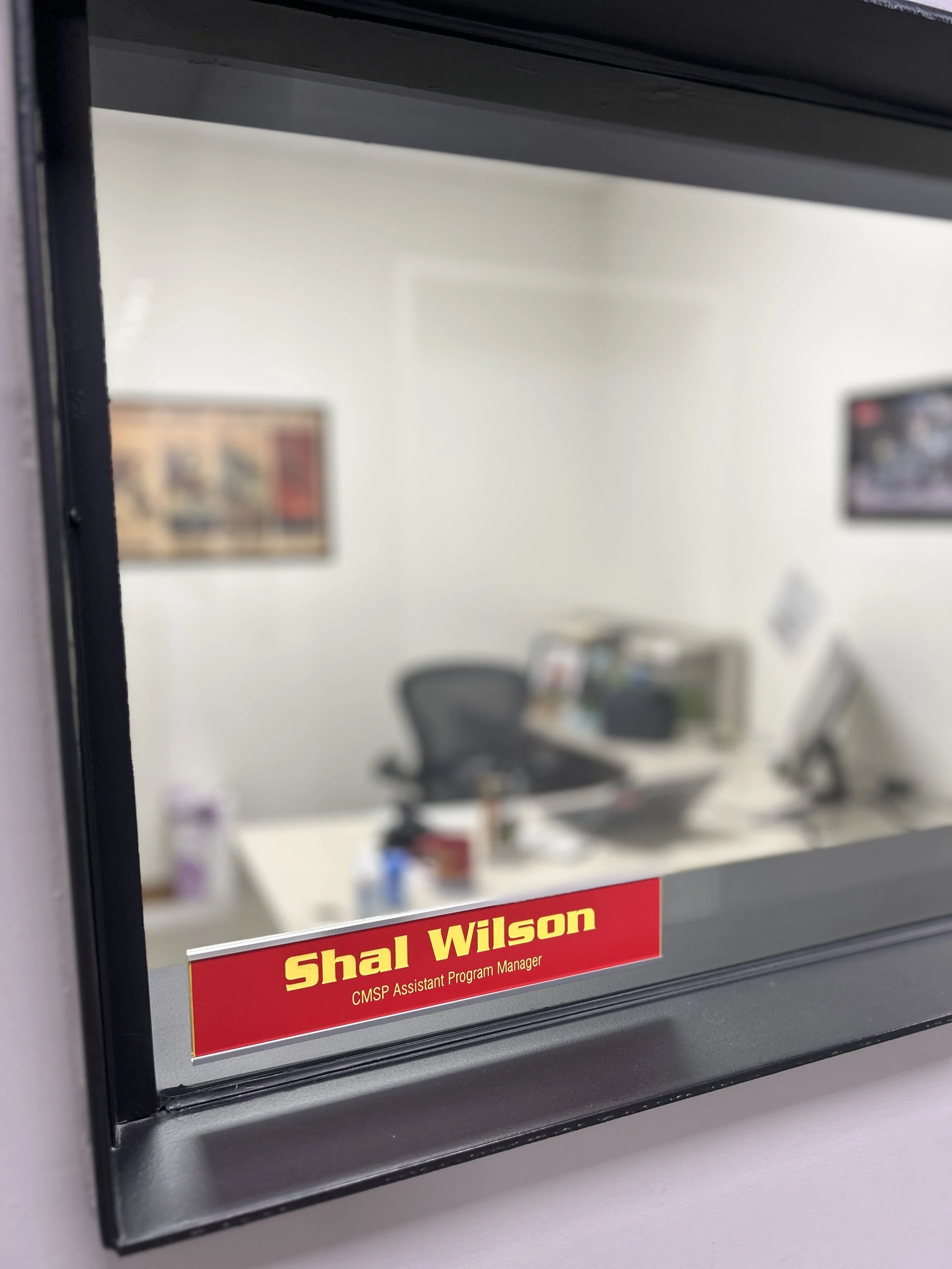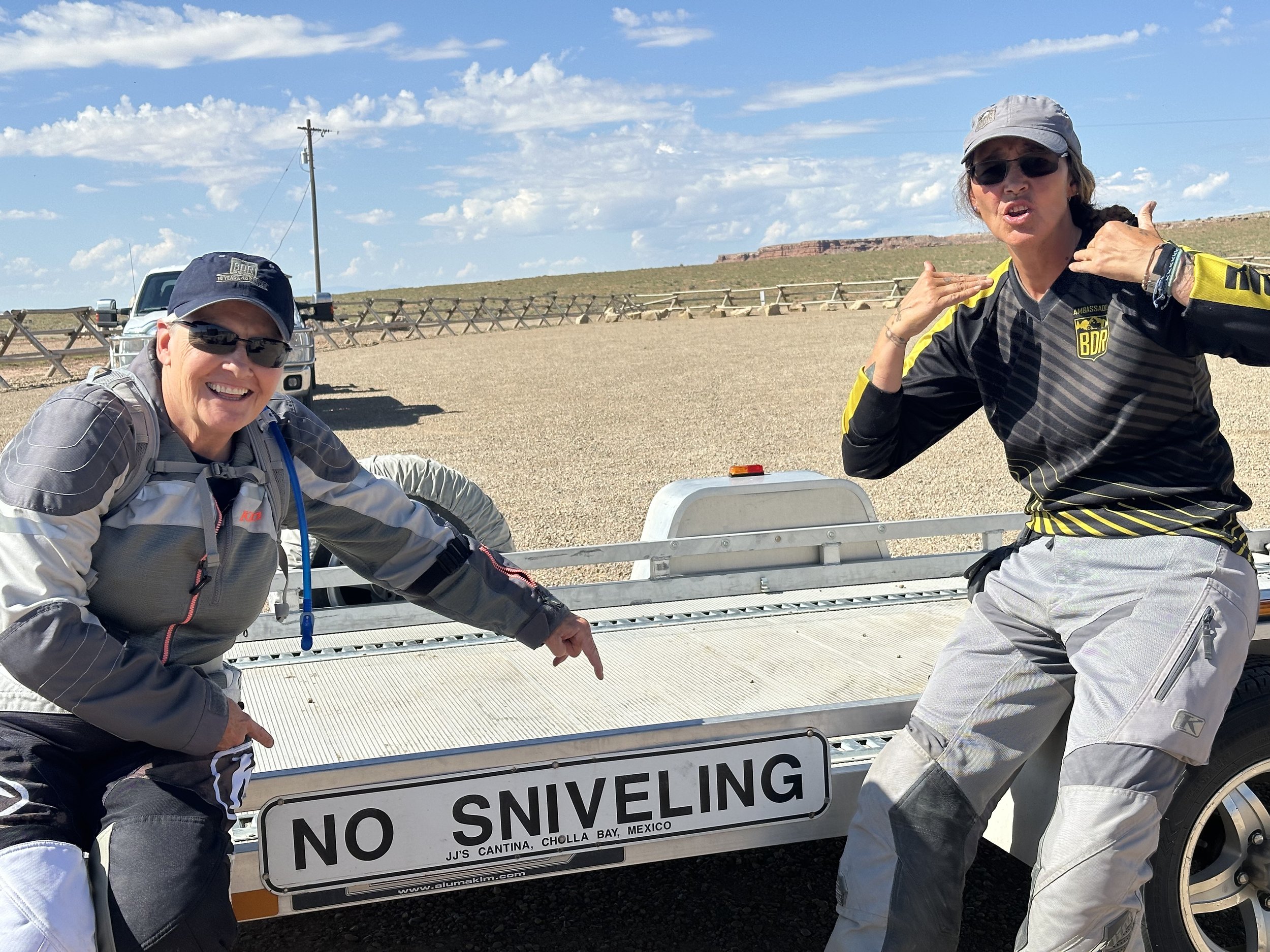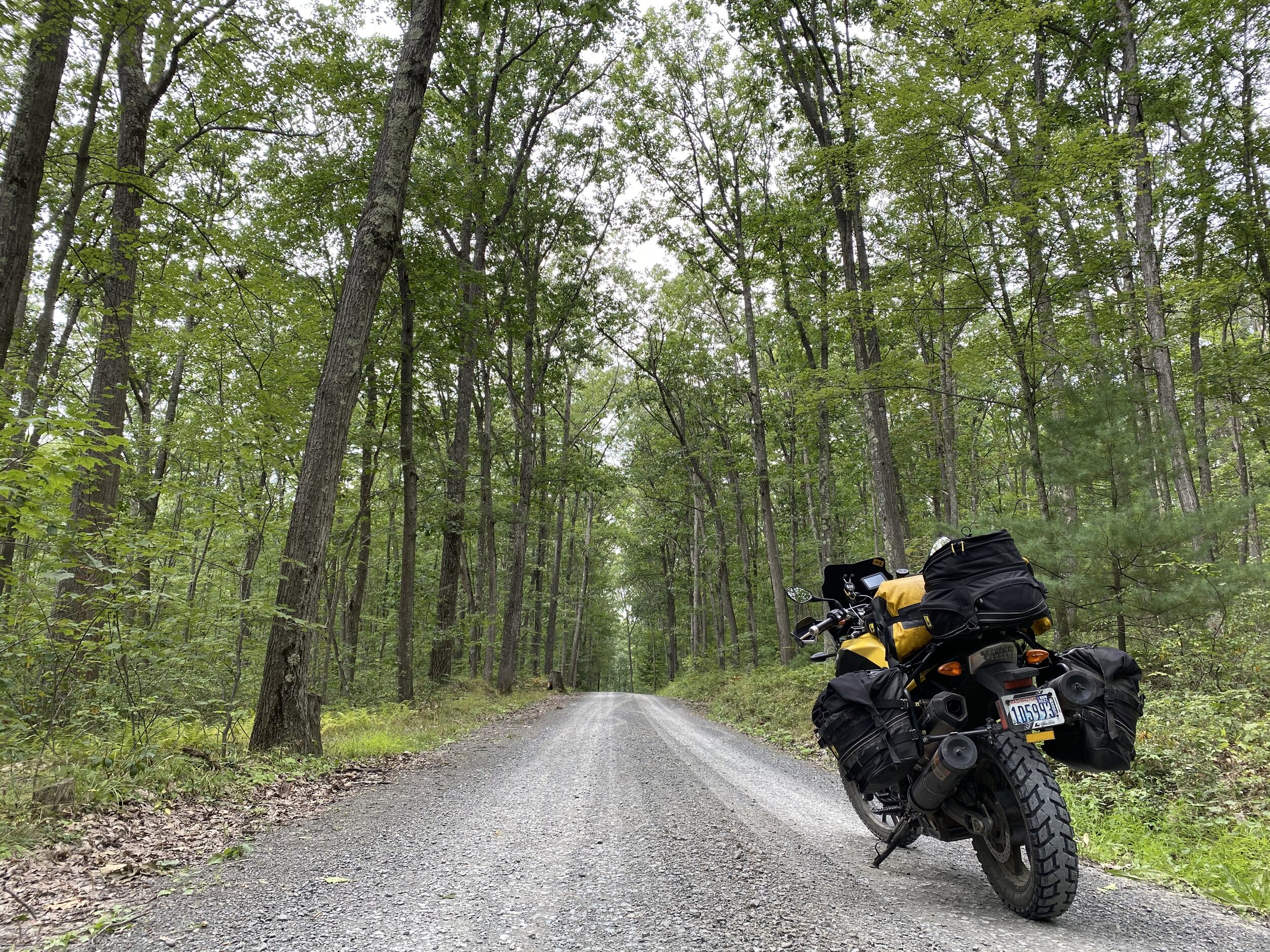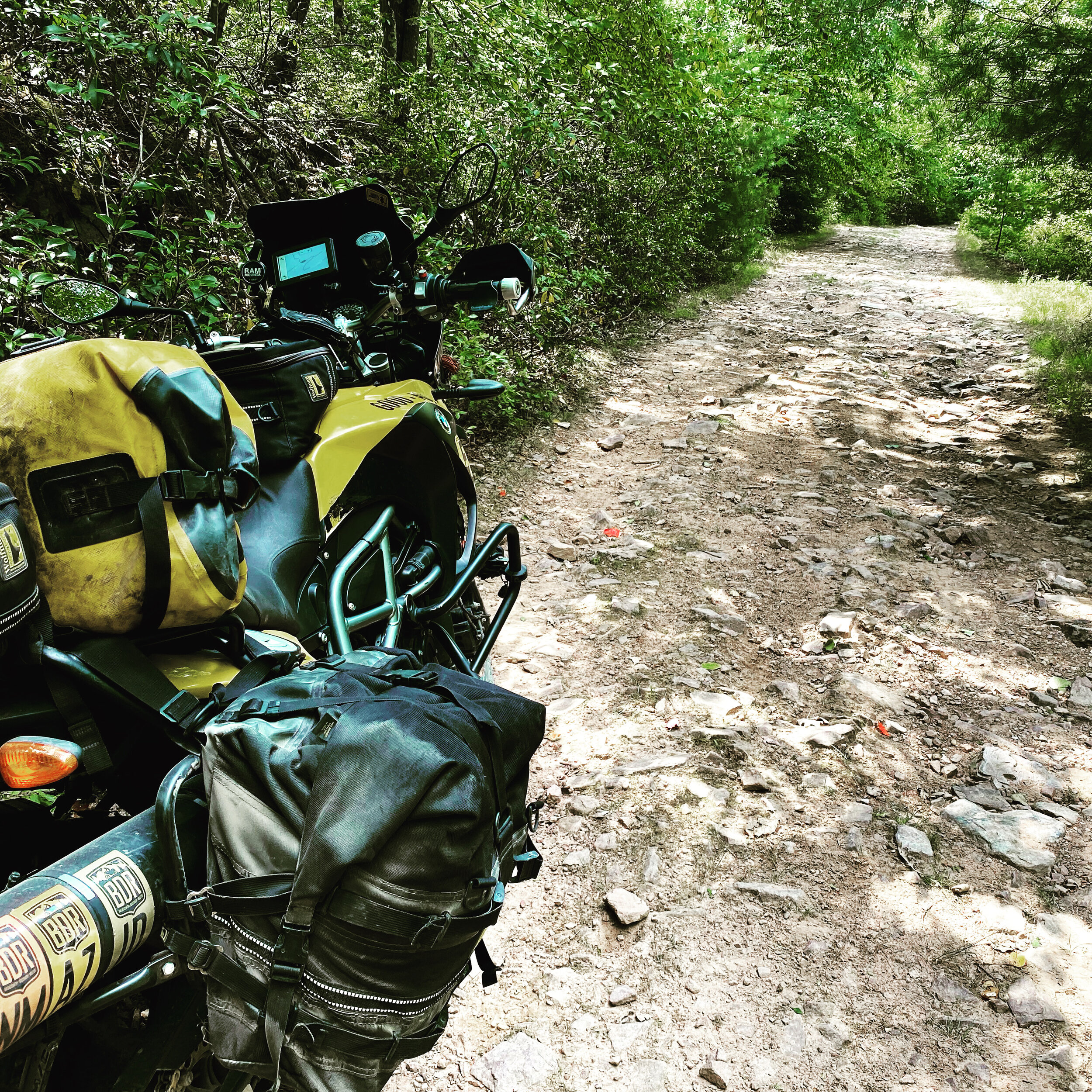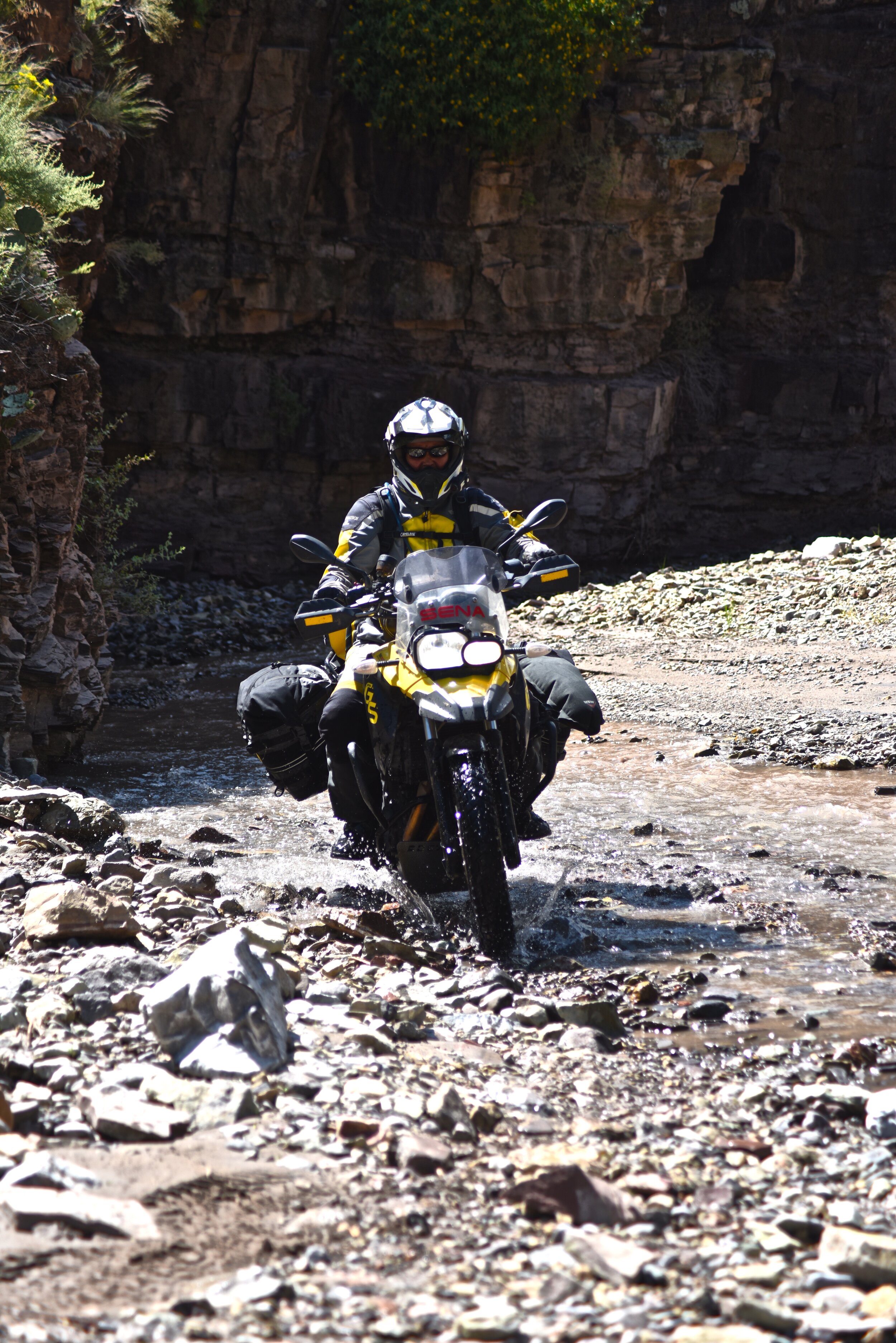
Train. Ride. Adventure.
Thank you for visiting my website!
For all adventure rider training, events, tours, and outrides, please visit SheADV. I’ve recently accepted a position as Assistant Program Manager for the California Motorcycle Safety Program and will be dedicating much of my time to this new role. That said, I’ll still be involved in some of the adventure events I’ve been a part of in the past—these will now be offered through SheADV.
Overnight Tour to Moab
May 5-6, 2025
We thought that sign was funny. Lol. Following the IFRD Women’s Campout at Rabbit Valley OHV, we are going to ride to Fruita and take the less traveled route to Moab. We will stay in Moab Monday night and then make our way back to Rabbit Valley on Tuesday. This is a great opportunity to get more seat time and see more of the high desert climate on the Colorado Plateau, while also having an experienced guide along side you.
Our route will follow scenic, easy dirt roads, double track, and some pavement. Riders will enjoy high desert, Book Cliffs, Colorado River Road and Kokapelli Trail. There will be old ruins, petroglyphs and pictographs, and towering canyon walls. Tour includes overnight hotel lodging at Field Station Moab. Pricing $427 per person double occupancy. A portion of the proceeds will be donated to SheADV. Riders’ food and fuel is not included in the tour price. Space extremely limited.
All Women’s Sunday Outride
July 13, 2025 10 a.m. to 2 p.m.
Join us for an all women's day ride! There's no better way to build confidence on a bike than getting out to ride. Not to mention a ride with new friends, an awesome trainer, and your own cheerleading squad. Join us! If you're coming from Shal's 2 day ADV Skills course on Friday & Sunday, you can add this ride when you register for the course. And if you're just joining us for the Sunday ride, sign up here! The ride will be a fun, beginner to intermediate ride with options of more challenging terrain or to keep it simple. And no matter what, there will be a crew to help out if/when needed. **What to Expect. These are the skills taught in Shal's ADV Skills course, and what we'll be incorporating into the day ride:** - **Foundational Skills:** Learn clutch control, throttle modulation, and proper braking techniques. - **Balance and Body Positioning:** Master body positioning for stability on challenging terrain. - **Obstacle Navigation:** Techniques to climb hills, descend safely, and maneuver through sand, gravel, and rocks. - **Trail Troubleshooting:** Real-world scenarios to build confidence in tackling unexpected challenges. - **Supportive Atmosphere:** A women-focused class led by an expert trainer for an inclusive and empowering experience.
Belize Training Tour
JANUARY 18-25, 2025 - HOPKINS, BELIZE SOLD OUT!
Want to escape the winter cold by joining us on a ladies weeklong training tour in Belize this January? I am teaming up with Emma, owner of Alternate Adventures for a week long training tour based out of Hopkins. We head there to explore the beautiful mainland while doing some off-road training. We will be riding 150-250cc dual-sport bikes through jungle and savanna, to waterfalls and swim holes. This tour is perfectly tailored for experienced street riders who are dirt curious, with no or limited off-road experience but with the desire to expand it. A spectacular opportunity to try some off-roading and also getting some coaching while having tons of fun with a group of similar-minded ladies all in warm weather. We will be staying in the beach village of Hopkins, by the Caribbean Sea, and opportunities to swim in the sea, swim holes and waterfalls will appear on a daily basis so we expect you to have your swimwear under your moto gear.
This is what is include:
7 nights accommodation
Airport shuttle transfers
Daily breakfast
Week long motorcycle rental
Gas
All park entry fees
5 fully guided moto excursions with training
One off-bike boating activity
Your investment: $2300 with a shared room
There is a $500 non-refundable deposit to hold your spot. This tour is limited to 8 participants.
The first tour SOLD OUT in just a few days, so don’t delay get registered right away.
You will need to arrange for your own flight:
You will need to make arrangements to fly into the Belize City's Philip S. W. Goldson
International Airport (airport code BZE) on January 18th and fly out on January 25th..
For more information on your stay in Hopkins, check out accommodations.
Recommended gear to bring:
Anyone looking to NOT have to take a helmet, Emma has 60 helmets to choose from but will
cost $25/week. Other recommended gear includes protective boots that are well over the
ankle bone, some form of armor for knees hips, elbows, shoulders, back, gloves and if using
knee pads, make sure they fit inside the pants. If wearing dirt bike pants, make sure they are
loose fitting/easy to get on and off as we will be swimming plenty. Wearing a light sweat
wicking under armor under the knee pads will help avoid rash.
To get registered or if you have more questions,
THIS TOUR WILL SELL OUT QUICKLY…. SO, DON’T DELAY!
Belize Training Tour
JANUARY 25 - FEBRUARY 1, 2025 - HOPKINS, BELIZE -SOLD OUT!
Want to escape the winter cold by joining us on a ladies weeklong training tour in Belize this January? I am teaming up with Emma, owner of Alternate Adventures for a week long training tour based out of Hopkins. We head there to explore the beautiful mainland while doing some off-road training. We will be riding 150-250cc dual-sport bikes through jungle and savanna, to waterfalls and swim holes. This tour is perfectly tailored for experienced street riders who are dirt curious, with no or limited off-road experience but with the desire to expand it. A spectacular opportunity to try some off-roading and also getting some coaching while having tons of fun with a group of similar-minded ladies all in warm weather. We will be staying in the beach village of Hopkins, by the Caribbean Sea, and opportunities to swim in the sea, swim holes and waterfalls will appear on a daily basis so we expect you to have your swimwear under your moto gear.
This is what is include:
7 nights accommodation
Airport shuttle transfers
Daily breakfast
Week long motorcycle rental
Gas
All park entry fees
5 fully guided moto excursions with training
One off-bike boating activity
Your investment: $2300 with a shared room, $2600 with a private room (limited availability), $2,900 with shared house (limited availability)
There is a $500 non-refundable deposit to hold your spot. This tour is limited to 10 participants.
The first tour SOLD OUT in just a few days, so don’t delay get registered right away.
You will need to arrange for your own flight:
You will need to make arrangements to fly into the Belize City's Philip S. W. Goldson
International Airport (airport code BZE) on January 18th and fly out on January 25th..
Once you have your flight information, please forward it to me as we will be planning
for a couple of different shuttle buses to get you to Hopkins, which is about 1.5 hours from
the airport and where we will be staying.
For more information on your stay in Hopkins, check out accommodations.
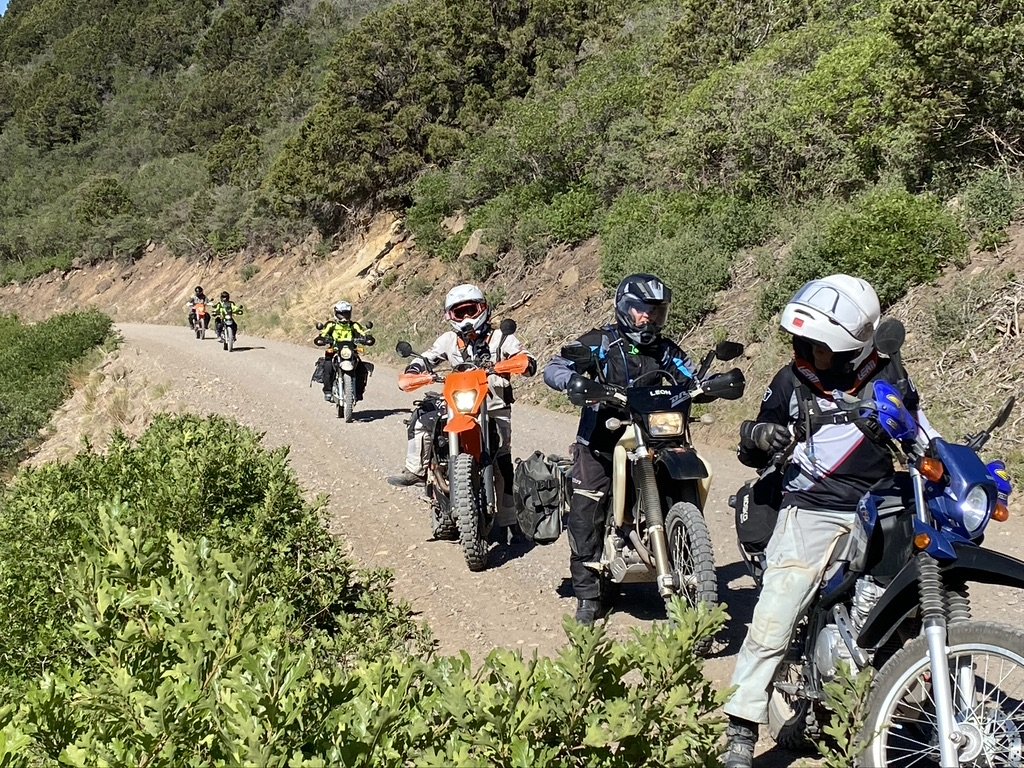
Immersion Training Tours?
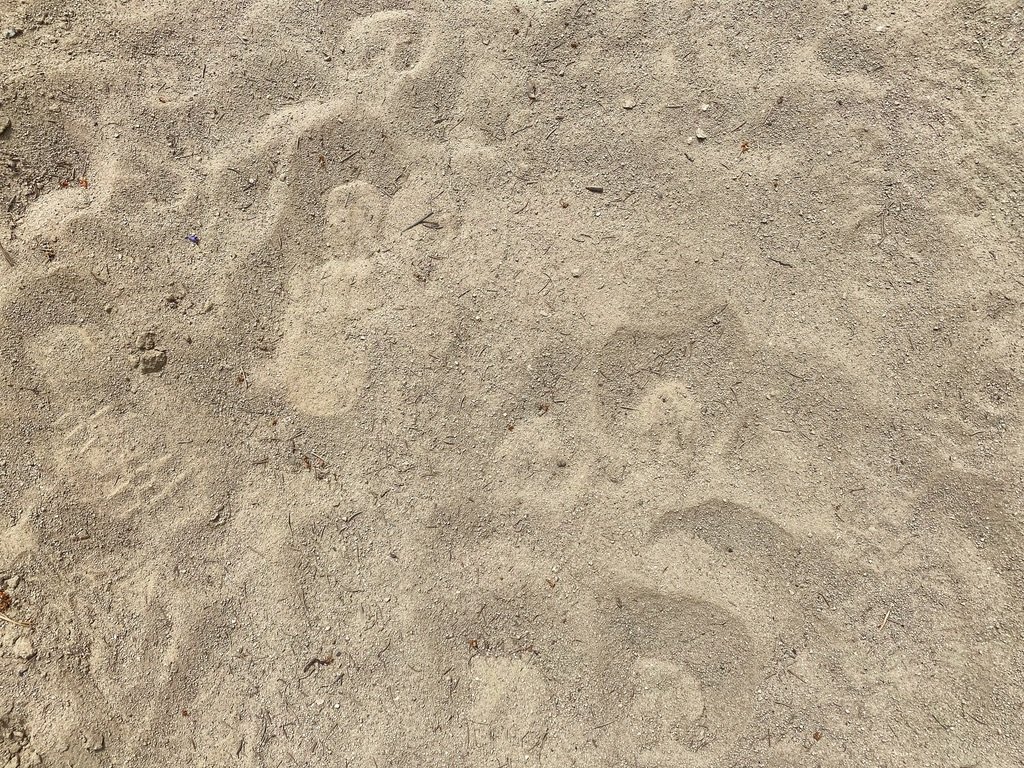
Immersion training tours are a great way to apply the skills right away that you learned in the 2-day course. In fact, research shows that within just one hour, if nothing is done with new information, most people will have forgotten about 50% of what they learned. After 24 hours, this will be 70%, and if a week passes without that information being used, up to 90% of it could be lost. With the Immersion Training Tours, you will continue to apply the skills learned and have the coaching needed to fine tune those skills and be able to apply them to real life situations.
You will have support every step of the way on a self supported tour. I will provide instruction, suggestions, and encouragement along the way. I’m an experienced backcountry tour guide, Certified Wilderness First Responder, versed in GPS navigation, and basic bike maintenance. Tours can include camping or luxury lodging, or anything in between. Camping can be a bit overwhelming for some, but I highly recommend it as it’s a great way to truly immerse yourself into the whole backcountry experience. Besides, you will have me right there helping you along the way.
What do you have in mind?
My specialty is using the Backcountry Discovery Routes and assisting those who want to take their Moto travels to another level. Contact me and we can discuss what getting into the backcountry means to you and how I can help. I can customize a multi-day backcountry training tour just for you or a small group of your friends.
Get out and explore!
Email: shalmariewilson@gmail.com
“I discussed my goals with Shal and scheduled her two-day Level I and II drills training, followed by two days of one-on-one “immersion training.” It is intended to apply those drills on off-road trails. I could not have asked for a better training experience!”
— Jonathan
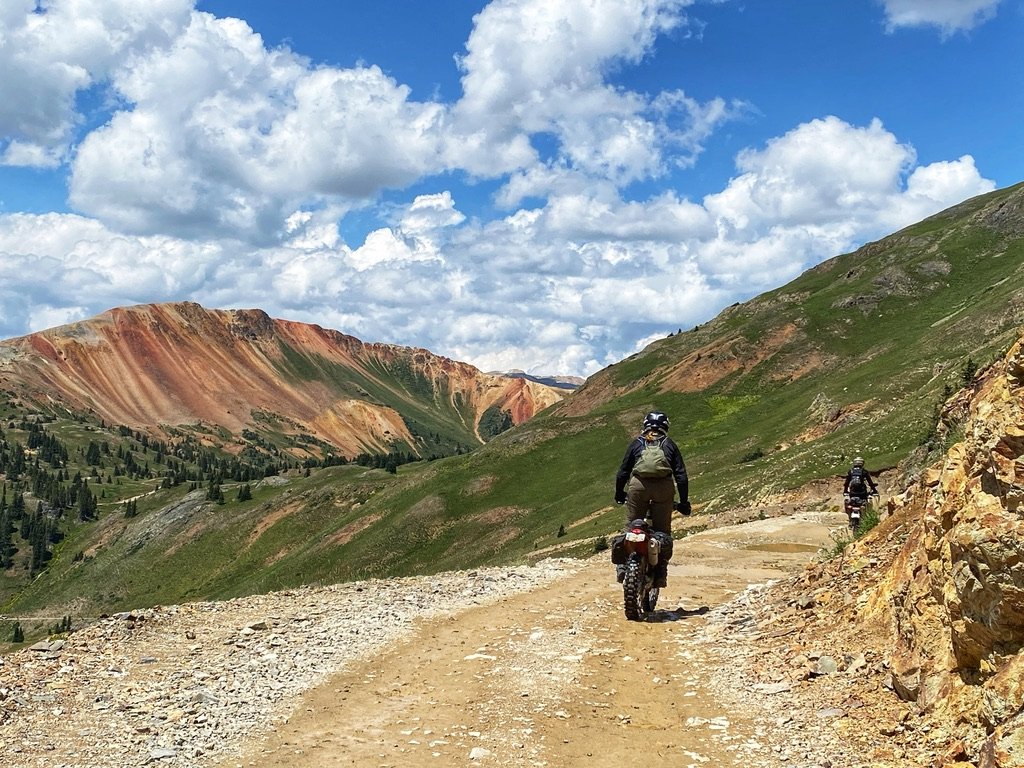
Rating System for Off-Street Terrain and Skills Needed for Such Terrain
Emphasis on Dual Sport and ADV Riding
I CREATED THIS RATING SYSTEM AS A GUIDE TO HELP YOU BETTER ASSESS
YOURSELF. WE WILL USE THIS AS A REFERENCE FOR THE TERRAIN WE WILL BE
COVERING EACH DAY SO YOU CAN MAKE BETTER DECISIONS ON WHAT YOU
ARE CAPABLE OF FROM DAY-TO-DAY.
THIS IS ONLY TO BE USED FOR MY TRAINING AND TOURS AND IS TO HELP YOU ASSESS WHERE YOUR SKILLS ARE IN RELATION TO THE TERRAIN MY TOURS WILL BE COVERING.
The purpose of this rating system is only to give dual sport and adventure riders a reference/guide, just like skiers and mountain bikers are given for the trails and routes they play on. When I rate a section, I am doing the best to reference the terrain that is present for the most part, but know that there could be a mix of different levels at times.
All the levels build on each other and riders must possess all of the skills from one level to the next. For example, to be considered a Level 3 Rider (Intermediate), you must be proficient at ALL the skills of a Level 1 and Level 2 Rider, as well as being proficient with the skills of a Level 3 Rider. If you possess all of the skills of a Level 1 and 2, and some of a Level 3 Rider, I’d consider you still in transition to being a Level 3 Rider.
Consider adding a level to the TERRAIN if:
A. Riding a 600cc + bike
B. Riding fully loaded
C. Conditions are wet
D. Lower fitness level
E. When fatigue level is higher on any given day for various reasons, such as your fitness level is being challenged because of riding for multiple days, you’re not fueling your body well enough, not getting enough rest, having lots of energy sucking activities like picking up bikes often, riding with tension, etc.
SPECIAL NOTE FOR TRAVELING SPEEDS: I am seeing or hearing about a fair amount of accidents and the contributing factor is excessive SPEED. Highway users are used to higher speeds on pavement, but when we are off-road, we need to consider that our TOTAL STOPPING DISTANCE will increase because we don’t have the traction we would on the pavement! To figure TOTAL STOPPING DISTANCE, take your MPH and multiply by 1.5. For example, 50 MPH x 1.5 = 75 feet traveled per second! Now, multiply the 75 by another 3-4 seconds, which is the time it takes your eyes to see you need to stop, your eyes to communicate to your brain and then your brain to communicate to your hands and feet that they need to apply the brakes. In those 3-4 seconds, you will have traveled 225-300 feet! That distance equates to about 15-20 car lengths to get stopped. Now add the fact you are on low traction terrain… ADD EVEN MORE TO YOUR TOTAL STOPPING DISTANCE OF 225-300 FEET. We need to be managing our speeds in order to manage the risks of having a collision with wildlife, oncoming roadway users, and sudden changes in road conditions, etc.
Level 1 Rider
Novice Level
IDBDR - Section 1
MABDR
TERRAIN FOR LEVEL 1 RIDERS
Gravel roads, well maintained and could include poorly maintained paved roads
Moderate wash boards
Freshly-graded road 1” deep
Slight steepness of hills with slight turns at entrance and/or exists
Shallow water crossings, less than 2”
Overall changing surfaces but good for cars, may have some embedded rock
MABDR
SKILLS NEEDED FOR LEVEL 1 RIDERS
Comfortable doing harder stops on low traction surfaces using both brakes (speeds of 12-18 mph)
Traction control and comfortable with bike moving around on 1” deep gravel roads
Ability to control bike while cornering on moderate wash boards
When cornering, understanding that using outside peg helps maintain traction
When cornering, understanding that using good body position helps maintain traction and control the bike
Good throttle control assists with overall bike control
Comfortable riding at 20-25 MPH on Level 1 terrain
MABDR
Riders should be proficient at ALL of Level 1 skills, prior to transitioning into a Level 2 Rider.
Level 2 Rider
Beginner Level
MABDR - Poe Daddy State Park
MABDR
TERRAIN FOR LEVEL 2 RIDERS
2-track with easy to go around obstacles/fairly well -maintained forest service roads
Patches of more loose surfaces, like moderate sand, softer gravel, shallow mud, loose shale, less than 3” deep
Occasional rocks/wide ruts (2’+)/logs less than 3”
Moderate steepness of hills, with some turns at the entrance and/or exists
Water crossings have a solid base and less than 3” deep
NEBDR - Class 4 Road
SKILLS NEEDED FOR LEVEL 2 RIDERS
Confident doing harder stops at higher speeds on low traction surfaces (speeds of 18-24 mph)
Comfortable moving around on the bike, no muscle tension
Comfortable keeping bike in balance on and off the bike
Ability to shift weight from ground to peg and alternating feet with smooth transitions
Control the bike using clutch and throttle interaction with no brakes, emphasis on hills
Ability to keep bike in tension using brakes, throttle and clutch when moving slow or during tight turns
Ability to steer the bike with the pegs
Ability to choose a line in order to cover the terrain/maneuver bike around some obstacles
Shifting and braking while standing
Ability to manage moderate short distant muddy and/or sandy conditions 20’ long and 2” deep
Higher comfort and control with slightly steeper hills Control = ability to manage the bike with lower speed, especially with down hills
Being able to pause at the top of a hill to assess what may be on the other side
Comfortable riding at 25-30 MPH on Level 1 terrain
Riders should be proficient at ALL of Level 2 skills, prior to transitioning into a Level 3 Rider.
Level 3 Rider
Intermediate Level
MABDR
NEBDR
TERRAIN FOR LEVEL 3 RIDERS
Rutted 2-track/narrower, less maintained forest roads
More rocks/shale, and obstacles like logs less than 6”
Steeper hills with hair pin turns at the entrance and/or exists
Standing water/larger mud puddles less than 6”
Water crossings less than 6” deep that may have a muddy or loose base
Moderate sand/silt levels (less than 6”), and narrower ruts (not much more than a tire width)
More hazards to maneuver around but still possible line choices
Hills have rock embedded, still can pick a line fairly easily
Some moderate off camber terrain
Winston, NM., Photo by Jon Beck
SKILLS NEEDED FOR LEVEL 3 RIDERS
Confident doing harder stops at higher speeds on low traction surfaces (speeds of 24-30 mph)
Comfortable moving around bike, loosely, including dabs
Ability to minimize turning radius for U-turns or close quarters (within 16’)
Ability to turn a bike around on a 2-track road
Very good at line selection, ability to put the bike where you want it
Confidence with bikes capability, lofting bike over 6” obstacles such as rocks, ruts, logs
For steep descents, ability to toggle between clutch and both brakes to control speed and avoid front wheel locking
Fine throttle and clutch control (no wheel spin, especially for steep ascents)
Ability to turn the bike around on a hill
Comfortable riding at 35-40 MPH on Level 1 terrain
Riders should be proficient at ALL of Level 3 skills, prior to transitioning into a Level 4 Rider.
Level 4 Rider
Advanced Level
NMBDR - Copper Creek, Photo by Jon Beck
NEBDR - Class 4 Road
TERRAIN FOR LEVEL 4 RIDERS
Rutted 2-track that may include wetter sections more over- growth
More loose, larger rock, greater than 6”, harder to pick a line
Deep sand and/or mud greater than 6”
Deep, narrow, long ruts greater than 50’
Steep hills with more obstacles, possible shale, hair pin turns, little to no line choose
Deeper water crossings greater than 6”, with looser base. The faster the water flow, the less deep to be equal to the above depth mentioned
Could encounter snow greater than 3”
Longer, possible steeper off-camber hills
Longer demanding sections of any of the above-mentioned terrains, can be a combination of terrains
SKILLS NEEDED FOR LEVEL 4 RIDERS
Confident doing harder stops at higher speeds on low traction surfaces (speeds of 30-40 mph)
Ability to do skid turns
Higher proficient level with moving around on the bike, including multiple dabbing
Very fine motor skills with all controls
Manage current bike very well (easily) on any of the varied terrain mentioned
Have the knowledge/skills to get yourself unstuck in deep sand and mud
Comfortable riding at 40-45 MPH on Level 1 terrain
NEBDR - Class 4
Riders should be proficient at ALL of Level 4 skills, prior to transitioning into a Level 5 Rider.
TERRAIN FOR LEVEL 5 RIDERS
Hard to pick a line, terrain best for dirt bikes
Larger amounts of loose shale, deep gravel greater than 6”, rocks greater than 6”
Lots of varied obstacles greater than 6”
Water crossings greater than 9” deep and/or extremely fast flowing
Combination of steep hills, hair pin turns, loose/large rocks/debris, ledges greater than 6”, slippery surfaces, overall varied obstacles, etc.
D.A.R.T Training, Photo by Susan Dragoo
SKILLS NEEDED FOR LEVEL 5 RIDERS
Confident doing harder stops at higher speeds on low traction surfaces (speeds of 40-50 mph)
Proficient at power slides
Lots of time with practicing skills/seat time/experience with level 4 and below on varied terrain.
Taking lower-level skills and making them harder by going slower, turning tighter, using one hand, etc.
We are not proficient at anything until we have put in 10,000 hours and have applied proper techniques.
Comfortable riding at 45-50 MPH on Level 1 terrain
Note: You are taking a HUGE risk if riding at higher speeds than 50 MPH on loose terrain. You need to consider your TOTAL STOPPING DISTANCE! At 50 MPH and on PAVEMENT, it will take you approximately 225-300 feet to get stopped. That is about 15-20 car lengths (ave. car length being 15 feet). Now, add the fact that you don’t have the traction you would on PAVEMENT. Total stopping distance will be even more. We need to be managing our speeds in order to manage the risks of having a collision with wildlife, oncoming roadway users, and sudden changes in road conditions, etc.
Riders should be proficient at ALL of Level 5 skills, in order to be consider a Level 5 Rider.
There is another great resource, by Bret Tkacs, to help you better assess your ADV skill set: Adventure Skill Rating System.
The following videos are from my very first tour that I co-led with Steph Terrien back in 2016. I think they are still inspiring and worth sharing. I hope you like them.
SheADV WABDR Tour - Part 1
Six adventurous women set out on a 5-day backcountry tour after attending a 3-day Touratech Rally in Plain, WA.
Watch and get inspired!
SheADV WABDR Tour - Part 2
“I would never had the courage to do this trip by myself. I’m appreciative and thankful for the knowledge you are sharing. I’m blown away and overwhelmed for the opportunity that I’ve gotten.”
- Adrienne
Watch and get inspired!
SheADV WABDR Tour - Part 3
“I fell a few times. This morning started off amazingly beautiful and I was thinking YES, this is why I do this! This afternoon has been challenging again with sand, silt, ruts and cliffs. I made it through some really hard ruts, but fell over in somethings that looked like nothing. But, we’re cooled off and all is going to be good again!”
- Angela
Watch and get inspired!
SheADV WABDR Tour - Part 4
“I have been enjoying the effort. I was introduced to adventure riding 7 years ago and I realized that this is how I’m going to see the world. This has been an immense gift. I’m excited to be doing it with you and being comfortable with your pace and getting to practice doing it well.”
- Deanna
Watch and get inspired!
SheADV WABDR Tour - Part 5
“I get the stress and fear and it would be an honor to help somebody with that.” - Steph
Watch and get inspired!
SheADV WABDR Tour - Part 6
“These are the people you want to ride with when something happens off the plan. they roll with it and even find laughter in it, they are the ones you want to be with.” - Adrienne
“Being back on a BDR and seeing people challenge themselves, jump off that cliff and being successful is pretty neat.” “This is why I do what I do!” - Shal
Watch it and get inspired!
